Content |
|---|
History
The origin of dogs Setter dates back to at least the second half of the 16th century: John Caius mentions them in 1570 The British book cart Canibus, What, as the name reflects, is dedicated to the dogs of Great Britain.
It is believed that the Irish Setter came up much later, in the XVIII century, as a result of a crossing. His ancestry is not known for sure, but it is believed to have developed from Irish Water Spaniel, with possible contributions from Irish Terrier, the English Pointer and the Gordon Setter. But, in early times it did not have the smooth mahogany red coat we know today, but a red and white fur, especially appreciated for hunting, since it was easy to spot in the bush. This Irish Red and White Setter -that still exists today, although it is more rare- would have gradually given way, in the course of the 18th century, to the Irish Red Setter. The Irish Red Setter stabilized as a distinct breed in the early 19th century, differing in particular by having longer legs than its bicolor ancestor.
Although its exact origins are unclear, the geographical origin of Irish Setter is well identified. Your story begins, of course, In Ireland, where hunters tried to develop a successful breed of dog for tracking, monitoring and recovery of game birds. They used it as a pointing dog that locates game by freezing in sample position, allowing the hunter to know where the bird is. The term “Setter” comes from this use for which the animal was developed. He was very appreciated from the beginning for his excellent nose, that allows you to detect odors in the air, while most hunting dogs track game on the ground. This feature made him very popular from the beginning..
In addition to his hunting skills, the Irish Red Setter it was also quickly distinguished by its elegant appearance and beautiful mahogany color. Since the early years of the 19th century, some breeders specialized in the production of specimens of this color. Jason Hazzard, of Timaskea, in County Fermanagh, Sir Saint George Gore and the Earl of Enniskillen they were some of the first breeders of the breed. These may include, the conde the Enniskillen He decided, already in 1812, who only wanted to have red-haired dogs in their kennels.
In 1862, a specimen called Palmerston stood out for the especially elongated shape of his head and the slenderness of his silhouette. These differences almost cost him his life, since its owner considered that these characteristics made it unsuitable for hunting and decided to drown it. A fan of the breed stepped in and saved him, then made him famous by presenting him in many dog ​​shows. Palmerston gave birth to a large number of offspring, and it is accepted that it appears in the family tree of most dogs Irish Red Setter that exist today. The success of Palmerston in the beauty contests in which he was exposed he was emulated, since without ceasing to be a recognized hunting dog, the Setter Irish Red later became a popular show dog.
The international spread of the Irish Setter
The Irish Setter was imported to the United States already in 1875 and quickly became a star. In fact, the first representative of the race that set foot in America, Elcho, became a star both for his presentations at dog shows and for his effectiveness in the field. It is not strange that the race is one of those recognized since its creation by the American Kennel Club (AKC). The first representative of the breed thus registered in 1878 it was called Admiral. With regard to the United Kennel Club (UKC), the other reference canine organization in the country, recognized the breed in 1914.
Shortly after his arrival in the country, the race that is sometimes called Red Setter to distinguish it from its white and red cousin it quickly became one of the most popular breeds at American dog shows. Among 1874 and 1948, nothing less than 760 of their representatives were rewarded in the rings. He was much less noticed for his field skills, since during the same period only 5 specimens were awarded for their hunting skills. This alerted some breed enthusiasts, that in 1940 published in the magazine Field and Stream a call for its rebirth as a hunting dog, its original function. His initiative was quite successful: So, although a lot of effort was put into its aesthetic characteristics, the Irish Setter was able to retain both of its functions and remains a highly prized hunting dog for tracking game birds, like the teal, the duck, partridge and quail. It is also common to distinguish between show and working bloodlines., that differ in size and robustness.
Of course, not only the United States adopted the Irish Setter. Your appreciation for the Fédération Cynologique Internationale (FCI) in 1954 contributed a lot to its spread throughout the world.
Recognitions “Irish Red Setter”
The Irish Setter is now recognized by the world's leading organizations, that distinguish it from Irish Red and White Setter. Many did not recognize the latter until much later.. In fact, the Irish Setter enjoys much greater popularity than its ancestor, although the latter is a bit at half mast…
This is the case, in particular, of United States, where he continues to be present both in the field with the hunters and in the exhibition rings. But, It is far from the heights it reached in the years 60 and 70, thanks mostly to Disney's production of 1962 in which appeared a Irish Setter call Big Red, as well as to Rey Timahoe, the famous White House dog during the presidency of Richard Nixon (1969 to 1974). Mid-years 70, came to occupy the third position in number of annual registrations in the AKC, going from about 4.000 puppies per year to more than 60.000. But, this fashion was ephemeral, and the popularity of Setter gradually declined from the second half of the decade of 1970. Today, is more likely to find the Setter around the post 75 (of something less than 200) regarding the number of annual registrations with the AKC. Keep descending, since at the dawn of the XXI century it was around the position 60.
Also in France, the Irish Setter became incredibly popular in the years 70. If at the beginning of the decade there were already more than 600 annual entries in the French Origin Book (LOF), this number shot up incessantly until approaching the 2.400 (four times more) in 1978. The reverse movement occurred in the following ten years, to the point of ending the decade of 1980 at around 700 u 800 annual births. Next, the number stabilized around 600 per year throughout the decades of 1990 and 2000, and then began to decline again in the decade of 2010, at around 500 births per year.
The recent decline in interest in the breed is also seen in other countries, like Britain. These may include, the number of annual registrations in the Kennel Club is around 700, while in early 2010 approached the 1.000.
Physical characteristics
The Puts irelandes is an active hunting dog, spirited and noble-looking, with a balanced and elegant constitution. These medium-sized dogs are distinguished by their rich mahogany red coat and fine, silky fur that extends over the ears, tail and chest. In general, it's a beautiful blend of refinement and robustness.
It is built around a deep chest that drops almost to elbow level and has a long, flat back., slightly sloping from withers to hindquarters, without an exaggerated fall. It is prolonged with a long, tapered tail, usually worn straight or even slightly curved up. Its hind legs are powerful and well developed, although its lower part is finer from the hock to the sole. They give him a good stride. The front legs are thinner, with straight and nervous forearms. The front joints are well bent, but not twisted in or out.
The head rests on a strong neck, although not very thick and slightly arched, that fits harmoniously between the shoulders. The skull is oval seen from above. The muzzle is moderately long and square, with lower and upper jaws of nearly equal length. The nose is always dark, black or chocolate, and the nostrils are wide open. The ears are placed behind the skull, slightly below eye level. They are thin and long, almost enough to touch the front of the muzzle when held taut. They hang with a sharp crease across the head. The eyes are almendrados, of medium size and quite distant from each other. They are hazelnut to dark brown in color and have a soft but alert expression.
The coat of the Irish Setter it is composed of an undercoat and a short topcoat on the top of the head and front legs, as well as on the tips of the ears. It is moderately long on the rest of the body and has long fringes on the ears., on the back of the legs and thighs and on the belly. Their feet have a good density of hair between the toes, like feathers. It also, despite its length, the coat is smooth and soft, with a shiny appearance.
Its color is one of the distinctive features of the breed. They are mahogany or dark brown, no trace of black. Some individuals have a hint of white on the chest or a thin white line on the top of the skull., but this is not particularly desirable.
Last, sexual dimorphism is only moderately pronounced in this breed: males are generally of 3 to 5 taller centimeters, but they are not, for example, significantly more massive. On the other hand, there may be actual physical differences depending on the purpose for which the animal is bred. These may include, individuals in show lines are usually more robust and larger than those intended for hunting or company, and their fur is also thicker and denser.
Size and weight
-
▷ Male size: Of 58 to 67 cm.
▷ female size: Of 55 to 62 cm.
▷ Male weight: Of 20 to 25 kg
▷ female weight: Of 18 to 23 kg
Character and skills
He gets along wonderfully with children, whose energy and enthusiasm perfectly match his own character. He especially enjoys play sessions with his humans and finds them ideal companions. But, care must be taken when in the company of very young children, as it can be jerky in its movements and can involuntarily push or even knock them down. In any case, a dog should never be left alone with a young child without adult supervision, and this applies to all races.
The Irish Red Setter generally not lacking in enthusiasm or curiosity. This curiosity - sometimes combined with his hunting instincts- means, However, easily distracted and it can be difficult to keep your attention. If we add to this that he is sometimes stubborn, it's easy to understand that your education can be a bit complicated at times. And the combination of these two traits can make learning a bit tricky at times!! It also has a great ability to nibble everything in its reach.. Training toys and chews for dogs should satisfy this urge., but at the beginning of learning, some objects can be destroyed.
In any case, the drive of the dog is a characteristic that is preserved for a long time, since it takes much longer than other races to reach a certain psychological maturity. For some people, Living with a puppy-minded dog at five can be challenging, but others love it. In any case, maintains a strong love for life into old age, and some dogs never settle.
In fact, the Irish Setter has a lot of energy to spare: originally bred for hunting, he is still very active and needs to spend his energy on daily walks and to be able to run without obstacles. Between an hour and an hour and a half of exercise a day is the minimum to keep you in good physical and mental health., and simple walks on a leash in the neighborhood are not enough for it to develop: you need a place away from traffic where you can run freely and safely. It is an excellent companion for those who want to go running with their pet, and is also happy to accompany bike rides.
Outings may also include time to swim, since the Irish Red Setter it is a water-loving breed. Swimming is also a good way for me to exercise.
The same goes for dog sports, that allow you to mobilize both your physical and mental capacities. The agility, obedience, crawling and rallying are disciplines that are perfectly suited to him and that he does not stop approaching with his usual enthusiasm.
In any case, an active master is necessary to keep it in good physical and mental shape: given your daily need for exercise, the lifestyle of elderly or sedentary people is not at all suitable for him.
As long as you have enough company and opportunities to exercise, he is very nice to live with and deserves his reputation in this regard.
No wonder, given your level of activity, the Irish Setter not suitable for apartment living. A house with a large fenced garden is a much more ideal living environment., but a fence is essential to prevent it from taking off. Like any self-respecting hunting dog, has a hard time restraining himself if he picks up interesting smells. In any case, even if the garden is big enough for him to run around, it's not a question of leaving it alone for a long time, because he needs to integrate into his family and interact with humans. He finds it difficult to tolerate loneliness and soon suffers from separation anxiety. The combination of lack of company and too much energy can take its toll on you, since it can lead to damage, plus other possible behavior problems (excessive barking to get attention, etc.).
Sharing a home with another species or with a representative of another species can be a smart way to avoid loneliness. Is able to get along with a cat or rodent once it has been raised and, Therefore, considers you a full member of your family. On the other hand, it is better to avoid living with birds, who are your favorite prey: his hunting instinct would have every chance of kicking in at some point and abruptly ending the experience. Obviously, the problem is especially acute in the case of individuals from hunting lines, whose instinct is the most advanced.
His sociability is not limited to family members, both animals and humans. In fact, he loves the company of the latter, and often welcomes strangers with enthusiasm: therefore, it would be quite unrealistic to expect to use it as a guardian. Having said that, Although it is not aggressive, can be protective if the situation calls for it. Will bark loudly when a stranger points their nose at him, which makes him at least a good watchdog.
His closeness to the human being, his gentle nature and intelligence make him a very good therapy dog, whether it is made permanently available to a person or used by an association that regularly intervenes in different institutions. In effect, can do wonders in accompanying patients who need emotional support.
Education
The Irish Red Setter not only is he smart and lively, He is also very cooperative in his education because he likes to work and make his masters happy.. But, keep in mind that it retains an exuberant personality for a long time, as if he were still a young cub, including a healthy dose of curiosity. This makes them easily distracted during sessions., and sometimes it can be hard to get their attention, or keep it for more than a few minutes. So, patience and a sense of humor are the keywords in the training of a Irish Setter, since he deserves his reputation for stubbornness, even stubborn at times. It is important to stay calm whatever happens, and act positive and kind.
In any case, things are easier because you really want to learn and you love challenges. So the challenge is essentially keeping it centered. The best way to do it is through play, with rewards and accolades. His very playful temperament means that he can resist if what is offered does not seem fun to him. Changing activities and rewards regularly can keep your interest and stimulate you more effectively.
Since he loves to run and has a strong hunting instinct, teaching your dog to hunt should be a high priority in your training program, What, as with any race, should start immediately. In more general terms, although in general it is full of good intentions, must learn as soon as possible to be obedient, at the risk of unleashing their tendency to be independent and stubborn.
Begin education of Irish Red Setter at a young age also helps to avoid boredom, since he needs a lot of stimuli to be happy. At eight weeks, is already capable of assimilating many things.
Regarding home training, not usually a source of major problems, although even 4 months the puppy may have difficulty controlling his bladder: if you live inside, it is therefore essential to take it outside regularly.
Like any dog, your socialization also benefits from being started without delay, and it goes much better since it is sociable by nature. Offer you many opportunities to meet all kinds of humans, companions and other animals, but also to face different environments and stimuli (noises, sounds, smells…) it is the best way to make him a perfectly balanced and very pleasant companion.
It also, especially likes to chew and nibble what is within reach. So, it is necessary not only to keep your precious belongings away, but above all to teach him to vent in a way acceptable to both him and his master: diverting their attention every time they start to chew or nibble on inappropriate things is a good way to gradually target this character trait.
Health
The Irish Setter it is a generally robust and healthy breed, and their representatives rarely have major health problems.
They are also relatively heat tolerant and, by its origin, they also acclimate well to reasonable cold and humidity. But, extreme temperatures are not really for him. Of course, must be able to take shelter in case of heat wave, but you should also be able to sleep in a heated place if the temperatures are below freezing.
The main diseases to which the breed is exposed are :
- The dilation-torsion stomach, which mainly affects large breeds of dogs and is fatal if the vet does not intervene quickly;
- The Hip Dysplasia, which is also common in large dogs and can be hereditary. It occurs when the thigh bone does not fit well in the hip joint and can cause difficulties in walking or running. Severe cases are usually corrected by surgery.;
- Osteocondrosis (in osteochondritis), ossification disorder that affects the cartilage of the joints and causes lameness. This disease is still little known, but it is suspected of having hereditary causes. It usually manifests itself in the animal's growth period and affects males more frequently than females.;
- The osteosarcoma, a bone cancer that mainly affects older animals and causes an increasingly pronounced and painful limp;
- Epilepsy, which is similar to what is also seen in humans and leads to often impressive seizures. But, there are various treatments that allow people with epilepsy to lead almost perfectly normal lives;
- The Hypothyroidism, a hormonal disorder that can present many different symptoms (weight gain, Dry Skin, hair loss…). It is usually treated with medications;
- The von Willebrand disease, an inherited bleeding disorder that can cause blood in the stool or bleeding from the gums or nose. There is no known cure for this disease, but it is possible to provide care to relieve symptoms;
- Insufficient adhesion of the leukocyte, a serious hereditary disease peculiar to the breed. It leads from a very young age to various and serious bacterial and viral infections because the white blood cells are unable to attack them. It is linked to a recessive gene, which means that an individual can be a carrier of it (and pass it on to their descendants) unaffected;
- The progressive retinal atrophy, an incurable hereditary disease that corresponds to a slow deterioration of the retina. Produces progressive loss of vision, first at night and then during the day;
- The entropion, a sometimes inherited eye disorder in which the eyelid rolls inward, irritating the eyeball. The problem can be treated with surgery;
- The otitis, an ear infection favored by the drooping shape of the ears.
Although the list of diseases the breed is predisposed to can be terrifying, do not forget that their representatives usually spend most of their lives in good health. A study conducted in 2004 by the British Kennel Club and the British Small Animal Veterinary Association revealed that cancer was responsible for the 27% of deaths and that old age was the second leading cause of death, with a 22% of the cases. In other words, these two causes alone account for one in two deaths, well ahead of cardiac problems (10% of the cases) and gastrointestinal disorders (8% of the cases).
However, since many of the conditions to which the breed is predisposed are or may be inherited, adopting a serious breeder of the Setters irlandes it is crucial to obtain an animal that is not only correctly socialized, but also and above all healthy, and that it probably still is. So, must be able to present the results of genetic tests performed to parents or offspring to rule out any transmission of inherited diseases. You must also present a certificate from a veterinarian attesting that the dog is in good health, as well as the health or vaccination card of the dog, in particular to confirm that you have received all necessary vaccinations.
Once the puppy has moved to its new home, care must be taken to respect his growth and not force him to do too many things too soon. So, any particularly strenuous or prolonged activity should be avoided until the puppy's skeleton has reached full maturity, what occurs in this breed at approximately two years of age. Otherwise, you run the risk not only of injury, but also to suffer consequences for life, that may be related to malformations, for example. The risk is all the greater as the Irish Setter is predisposed to various joint problems.
It also, the adoption of a healthy dog ​​should not do without regular visits to the vet, At least once a year, to allow early detection of a potential problem, before it ends up acquiring very serious proportions. It is also an opportunity to carry out any necessary vaccine recalls..
Always in the field of prevention, it is the owner's responsibility to ensure that their animal's parasitic protection remains active at all times and, for it, renew treatments whenever necessary.
Life expectancy
13 years
Grooming
The care of Irish Red Setter takes time and effort. In fact, its beautiful long, silky coat needs to be brushed once or twice a week to stay shiny and knot-free. This regular brushing also stimulates the follicles that cause hair growth., making the coat healthier. During the molting period, in spring and autumn, hair loss is much greater, so daily brushing is recommended to help remove dead hairs.
Unless, Of course, that the Irish Setter don't need more than two baths a year, unless, Of course, that has gotten especially dirty. Care must be taken to always use a shampoo specifically designed for canines., as there is a risk that the skin will dry out due to a product that is too aggressive. In fact, the pH of dog's skin is not the same as that of human skin.
Their floppy ears also require regular maintenance., as they are a breeding ground for infections. So, should be checked weekly and cleaned with a slightly damp cloth to avoid accumulation of dirt and moisture. The same should be done after every prolonged time outdoors, for example if it is used to hunt. After bathing or soaking outdoors, it is also useful to dry them, again to prevent moisture build-up.
Your eyes should also be carefully examined and cleaned every week., again to prevent dirt from getting into them.
Coat grooming sessions also offer the opportunity to care for your dog's teeth by brushing them with dog toothpaste.. This helps prevent tartar buildup and, Therefore, reduce the risk of bad breath and, above all, of oral diseases. It is best to avoid doing it less than once a week, and the ideal is to take care of it regularly.
Given your level of activity, this dog's claws tend to wear out naturally, so no need to cut them manually. But, it is better to check it every month to make sure that it is so. In any case, if you hear them rubbing against the ground when walking on smooth ground, means that they have become too long. Beyond being then prevented from walking, they can break and potentially injure you.
Whether the fur, the ears, the eyes, teeth or claws, maintaining a Irish Red Setter should not be done randomly, at the risk of hurting or even injuring you. The first time, a visit to a professional groomer or veterinarian can be a great way to learn the correct mannerisms from a professional.
In any case, no reason to wait to start: Familiarizing your dog with these sessions from a young age is the best way for him to cooperate when he needs to be handled, and you can even make maintenance sessions moments of shared complicity.
Manipulations are also useful when you return from a long period in nature, since then it is necessary to carefully examine their fur, legs and ears to detect the possible presence of infections or small wounds, but also parasites, thorns, skewers, etc.
Utility
The Irish Setter It was originally designed and developed to accompany hunters in their search for game birds.. It was - and still is- especially appreciated for its qualities as a showing dog: It is excellent for locating game and positioning itself in a sample position so that the hunter knows where the bird is.
His grace, the beauty of its demeanor and its reddish-cashé coat also made it popular in dog shows already in the second half of the 19th century.
Today they are still recognized and appreciated for these two uses., but have also won hearts as affectionate companion dogs, smart and endearing. They are wonderfully suited to family life so owners can give them all the exercise they need, a task that can be delegated, at least in part, In the kids, with those who love to play.
Dog sports are another great way for him to exercise: excels in agility competitions, obedience and tracking, for example.
Last, its closeness to humans, his sensitivity and sweetness explain why he is also found as a therapy dog, for example in schools, hospitals and nursing homes.
On the other hand, the fact that it lacks all aggressiveness, enjoys the company of humans so much and is generally very welcoming to strangers implies that he cannot assume the role of guardian. On the other hand, it is an excellent warning dog, since it does not stop warning the arrival of a stranger.
Price
The popularity of the Irish Red Setter makes it not hard to find, as many breeders can be found both on European and North American soil.
The price of a puppy usually ranges from 500 and 1000 EUR. The average is slightly less than 800 EUR, no significant differences between males and females.
whatever the country, the price necessarily varies depending on the reputation and prestige of the hatchery from which it comes, of his lineage, as well as its intrinsic characteristics, and in particular of its greater or lesser conformity with the standard. This explains why there can be significant price differences between individuals of the same litter.
Characteristics "Irish Red Setter"
Coexistence is important that you have with your new friend. Before considering the acquisition of a dog of the breed "Irish Red Setter" you know certain factors. Not all breeds of dogs are apt to live in an apartment, you must take into account his character, their need for exercise, their interaction with other pets, their care and if you have small children, their level of tolerance towards them.
Adaptation ⓘ2.0 out of 5 stars (based on 1 review)
|
friendly dog ⓘ5.0 out of 5 stars (based on 1 review)
|
hair loss ⓘ3.0 out of 5 stars (based on 1 review)
|
|---|---|---|
Affection level ⓘ5.0 out of 5 stars (based on 1 review)
|
Need for exercise ⓘ4.0 out of 5 stars (based on 1 review)
|
Social need ⓘ5.0 out of 5 stars (based on 1 review)
|
Home ⓘ3.0 out of 5 stars (based on 1 review)
|
Toilet ⓘ3.0 out of 5 stars (based on 1 review)
|
Friendly with strangers ⓘ4.0 out of 5 stars (based on 1 review)
|
barking ⓘ2.0 out of 5 stars (based on 1 review)
|
Health ⓘ3.0 out of 5 stars (based on 1 review)
|
Territorial ⓘ3.0 out of 5 stars (based on 1 review)
|
Cat friendly ⓘ3.0 out of 5 stars (based on 1 review)
|
Intelligence ⓘ4.0 out of 5 stars (based on 1 review)
|
Versatility ⓘ3.0 out of 5 stars (based on 1 review)
|
Child friendly ⓘ5.0 out of 5 stars (based on 1 review)
|
Surveillance ⓘ3.0 out of 5 stars (based on 1 review)
|
joy ⓘ5.0 out of 5 stars (based on 1 review)
|
Images "Irish Red Setter"
Photos:
1 – Irish Red Setter Vigo – Galicia – Spain – 06-10-2006 by Luis Miguel Bugallo Sánchez (Lmbuga Commons)(Lmbuga Galipedia)Published by / Publish by: Luis Miguel Bugallo Sánchez, CC BY-SA 3.0, via Wikimedia Commons
2 – Irish Red Setter by Adam Ziaja, CC BY-SA 3.0, via Wikimedia Commons
3 – Irish Setter head by Ehog.hu, CC BY-SA 4.0, via Wikimedia Commons
4 – Irish Setter of 9 years. by Can Nefesoglu, CC BY-SA 4.0, via Wikimedia Commons
5 – Irish Setter by Philipp Schiffmann, CC BY-SA 2.0 OF, via Wikimedia Commons
6 – Irish Red Setter by https://commons.wikimedia.org/wiki/File:Irish_setter_(dog).jpg
Videos "Irish Red Setter"
Type and recognitions:
- FCI CLASSIFICATION: 120
- Group 7: Pointing Dogs
- Section 2: British and Irish Pointers and Setters. 2.2 Setter. With proof of work..
Federations:
- – FCI – Group 7: Pointing Dogs. – Section 2: British and Irish Pointers and Setters. 2.2: Setter ⓘ
- – AKC – Sporting ⓘ
- – ANKC – Group 3 (Gundogs) ⓘ
- – CKC – Sporting Dogs ⓘ
- – KC – Gundog ⓘ
- – NZKC – Gundog ⓘ
- – UKC – Gun Dogs ⓘ
Alternative names:
1. Red Setter, Irish Setter (English).
2. Setter irlandais (French).
3. Irischer Roter Setter (German).
4. (em inglês: Irish Red Setter) (Portuguese).
5. Setter irlandés (español).
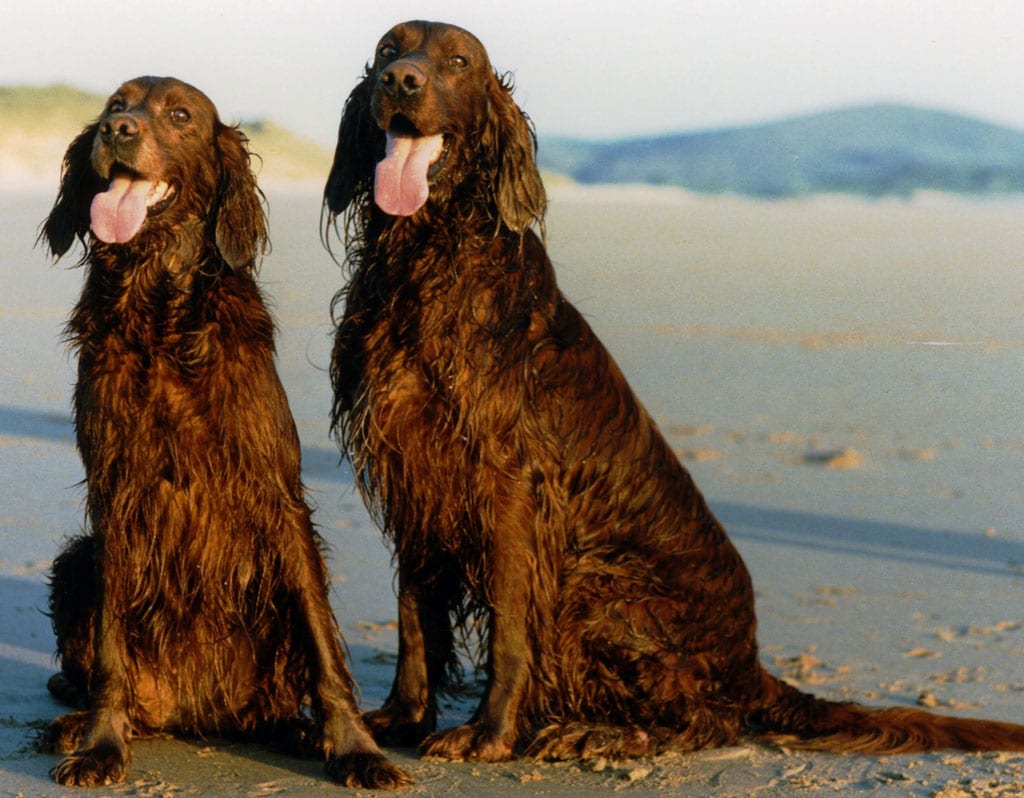
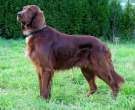
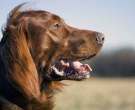

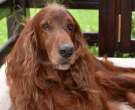
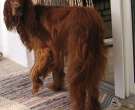
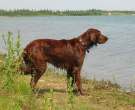
 IRISH SETTER ð Characteristics, Character and Health
IRISH SETTER ð Characteristics, Character and Health Dog Breed Video: Irish Setter
Dog Breed Video: Irish Setter IRISH SETTER ð Characteristics, Character and Health
IRISH SETTER ð Characteristics, Character and Health Irish Setter
Irish Setter